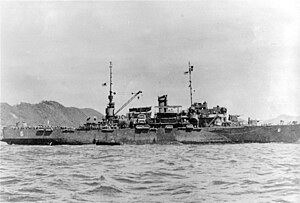 Monitor in 1945 Monitor in 1945
| |
| History | |
|---|---|
| Name | USS Monitor |
| Namesake | USS Monitor |
| Builder | Ingalls Shipbuilding Corporation, Pascagoula, Mississippi |
| Laid down | 21 October 1941, as AN-1 (Net laying ship) |
| Launched | 29 January 1943 |
| Commissioned | 14 June 1944 |
| Decommissioned | 22 May 1947 |
| Out of service | 1961 |
| Reclassified |
|
| Stricken | 1 September 1961 |
| Honours and awards | 4 battle stars (World War II) |
| Fate | Scrapped, 1961 |
| General characteristics | |
| Class and type | Osage-class vehicle landing ship |
| Displacement |
|
| Length | 458 ft (140 m) |
| Beam | 60 ft 2 in (18.34 m) |
| Draft | 20 ft (6.1 m) |
| Propulsion |
|
| Speed | 21 knots (39 km/h; 24 mph) |
| Capacity | 19 × LVTs or 29 DUKWs |
| Troops | 122 officers, 1236 enlisted men |
| Complement | 458 officers and enlisted men |
| Armament |
|
USS Monitor (LSV-5/AN-1/AP-160/MCS-5) was an Osage-class vehicle landing ship built for the United States Navy during World War II. She was named after the original USS Monitor (the first ironclad warship commissioned by the USN and the first U.S. Naval vessel to bear the name), and was the second U.S. Naval vessel to bear the name.
Laid down on 21 October 1941 as netlayer AN-1 by the Ingalls Shipbuilding Corporation of Pascagoula, Mississippi and launched on 29 January 1943; sponsored by Mrs. John A. Terhune. She was redesignated AP-160 on 2 August 1943, and first commissioned on 18 March 1944. Due to delays in construction, the ship was transferred under her own power to Todd Shipyards, Brooklyn, New York for completion on 2 April. Redesignated as a Landing Ship, Vehicle, on 21 April 1944, USS Monitor (LSV-5) was commissioned for service on 14 June 1944.
Service history
Philippines, 1944–1945
Following shakedown in Chesapeake Bay, Monitor steamed via the Panama Canal to Pearl Harbor, arriving 10 August. Loading troops, cargo and amphibious DUKWs, the ship joined the 3rd Fleet off Leyte in October, participating in the landings at Leyte Gulf on 20 October and then removing wounded for transport to Morotai. She returned to Leyte with reinforcements 14 November and then sailed for Sansapor where she reloaded troops and equipment for the invasion of Luzon. Steaming for Lingayen Gulf, under air attack much of the way, the vehicle landing ship put her assault force ashore 9 January 1945 and then stood by in support, shooting down an enemy aircraft that night with only 28 rounds of 40 mm expended.
In the closing days of January, the ship took part in two invasions in support of the Lingayen operation, the landing on San Felipe and La Paz on 29 January, and the landing of Army Rangers on Grande Island in Subic Bay on 30 January.
Okinawa, 1945
Monitor then steamed for Guadalcanal where she loaded marines for transport to Okinawa, participating in the "D-Day" landings on 1 April and then standing by off that hotly contested island until 10 May when she sailed for the United States. During May, June, and July, the LSV made several trips between Pearl Harbor and the west coast with passengers and cargo and then in August proceeded to Saipan to load medical personnel and supplies, departing on the 15th for Japan.
Occupation duties, 1945–1947
Joining the 3rd Fleet off Tokyo, Monitor took on board 1,000 sailors from battleships Missouri, Indiana, Wisconsin, Massachusetts, and Alabama, conducting the first landing on the Japanese homeland on 30 August. The ship then served as a hospital ship to assist in the removal of Allied prisoners of war, over 8,000 repatriates being received on board and helped on their way before the amphibious vessel departed Japan 19 September. Returning to the United States, Monitor was assigned to "Operation Magic Carpet," the massive program to bring the troops home. She operated on this mission until decommissioning in the Reserve Fleet, Galveston, Texas 22 May 1947.
Reclassified MCS-5 on 18 October 1956, Monitor was struck from the Naval Vessel Register on 1 September 1961 and transferred to the Maritime National Defense Reserve Fleet in Beaumont, Texas.
Monitor earned four battle stars for World War II service.
See also
Citations
References
- Egan, Robert S. (2015). "USS Terror and her Family: Part 2: The Netlayers: USS Monitor and Class". Warship International. LII (1): 42–64. ISSN 0043-0374.
- Egan, Robert S. (2016). "USS Terror and her Family: Part 2: The Netlayers: USS Monitor and Others". Warship International. LIII (1): 43–57. ISSN 0043-0374.
- Egan, Robert (June 2019). "USS Terror and her Family: Part 3: The Conversions (1st Installment)". Warship International. LVI (2): 139–165. ISSN 0043-0374.
- Egan, Robert (September 2019). "USS Terror and her Family: Part 3: The Conversions (2nd Installment)". Warship International. LVI (3): 211–247. ISSN 0043-0374.
![]() This article incorporates text from the public domain Dictionary of American Naval Fighting Ships.
This article incorporates text from the public domain Dictionary of American Naval Fighting Ships.
External links
- "Monitor". Dictionary of American Naval Fighting Ships. Retrieved 29 April 2007.
- "AN-1 / AP-160 / LSV-5 / MCS-5 Monitor". Amphibious Photo Archive. Retrieved 29 April 2007.
| Vehicle landing ships of the United States Navy | |
|---|---|
| U.S. Mine Countermeasures Support Ships | |
|---|---|
| List of mine warfare vessels of the United States Navy |